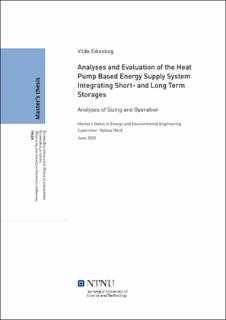| dc.contributor.advisor | Nord, Natasa | |
| dc.contributor.author | Eikeskog, Vilde | |
| dc.date.accessioned | 2021-09-20T16:47:47Z | |
| dc.date.available | 2021-09-20T16:47:47Z | |
| dc.date.issued | 2020 | |
| dc.identifier | no.ntnu:inspera:57318108:20937931 | |
| dc.identifier.uri | https://hdl.handle.net/11250/2779629 | |
| dc.description.abstract | Termiske energisystemer som leverer oppvarming og kjøling til en bygning eller et område har blitt mer kompliserte det siste tiåret. Kjølebehovet for bygninger i Norge har økt, og dette har resultert i mer komplekse termiske energisystemer som krever både oppvarming og kjøling samtidig. Varmepumpeteknologier kan levere oppvarming og kjøling på samme tid, og derfor kan det være gunstig løsning for å levere det termiske energibehovet som er ønsket.
Fra en gjennomgang av eksisterende modeller av termiske energisystemer og anvendte termiske energisystemer i Norge utvikles en modell av en bergvarmepumpe i et varme- og kjølesystem som integrerer langsiktig og kortvarig energilagring. Modellen består av tre delmodeller; en brønnpark, en varmepumpe og en varmelagringstank. Borehullskonfigurasjonen fungerer som et sesongbasert termisk energilager som termisk lades i sommersesongen og tappes i vintersesongen. Varmelagringstanken er koblet mellom kondenseren og varmesystemet og fungerer som en kortvarig energilagring for å oppnå jevn drift av systemet ved å redusere forstyrrelsene. Modellen brukes til å utføre analyser av flere strategier for dimensjonering av komponenter, kontrollstrategier, forskjellige belastninger og forskjellige kompressorer. To ulike belastninger med oppvarming og kjøling brukes til å evaluere modellen for en belastning med store sesongmessige forskjeller og en belastning med mer konstant etterspørsel gjennom året. Fra analysene i modellen kan det konkluderes at forholdet mellom kjøle- og varmebehov påvirker energibalansen i brønnparken. Kompressorens temperaturløft er avgjørende for ytelsen til varmepumpen. | |
| dc.description.abstract | Thermal energy systems that provide heating and cooling to a building or area have become more complex over the last decade. The cooling demand for buildings in Norway has increased, and this has resulted in more complex thermal energy systems that require both heating and cooling simultaneously. Heat pump technologies can provide heating and cooling at the same time, and therefore it is often a beneficial solution for providing thermal energy to a building.
From a review of existing thermal energy models and applied thermal energy plants in Norway, a model of a ground source heat pump in a heating and cooling plant integrating long- and short term energy storage is developed. The model consist of three sub-models; a borehole configuration, a heat pump, and a water storage tank. The borehole configuration works as a seasonal thermal energy storage thermally charged during summer and drained during the winter. The water storage tank is connected between the heat pump and the heating system and work as a short term energy storage to obtain smooth operation of the system by reducing the disturbances. The model is used to perform analyses of several strategies for sizing the components, control strategies, various loads, and different compressors. Two distinct loads of heating and cooling demand are used to evaluate the model for loads with significant seasonal differences and a more constant demand. From the analyses in the model, the ratio of the cooling and heating demand influences the energy balance in the borehole storage. If the ratio is too small the borehole configuration will become supercooled with time. The temperature lift of the compressor is significant to the performance of the heat pump and the performance increase with a reduced temperature lift. | |
| dc.language | | |
| dc.publisher | NTNU | |
| dc.title | Analyses and Evaluation of the Heat Pump Based Energy Supply System Integrating Short- and Long Term Storages – Analyses of Sizing and Operation | |
| dc.type | Master thesis | |
